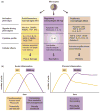Mechanisms of tendon injury and repair
- PMID: 25641114
- PMCID: PMC4418182
- DOI: 10.1002/jor.22806
Mechanisms of tendon injury and repair
Abstract
Tendon disorders are common and lead to significant disability, pain, healthcare cost, and lost productivity. A wide range of injury mechanisms exist leading to tendinopathy or tendon rupture. Tears can occur in healthy tendons that are acutely overloaded (e.g., during a high speed or high impact event) or lacerated (e.g., a knife injury). Tendinitis or tendinosis can occur in tendons exposed to overuse conditions (e.g., an elite swimmer's training regimen) or intrinsic tissue degeneration (e.g., age-related degeneration). The healing potential of a torn or pathologic tendon varies depending on anatomic location (e.g., Achilles vs. rotator cuff) and local environment (e.g., intrasynovial vs. extrasynovial). Although healing occurs to varying degrees, in general healing of repaired tendons follows the typical wound healing course, including an early inflammatory phase, followed by proliferative and remodeling phases. Numerous treatment approaches have been attempted to improve tendon healing, including growth factor- and cell-based therapies and rehabilitation protocols. This review will describe the current state of knowledge of injury and repair of the three most common tendinopathies--flexor tendon lacerations, Achilles tendon rupture, and rotator cuff disorders--with a particular focus on the use of animal models for understanding tendon healing.
Keywords: animal models; healing; inflammation; tendinopathy.
© 2015 Orthopaedic Research Society. Published by Wiley Periodicals, Inc.
Figures


References
-
- Jarvinen TA, Kannus P, Maffulli N, et al. Achilles tendon disorders: etiology and epidemiology. Foot and ankle clinics. 2005;10:255–266. - PubMed
-
- Raikin SM, Garras DN, Krapchev PV. Achilles tendon injuries in a United States population. Foot & ankle international/American Orthopaedic Foot and Ankle Society [and] Swiss Foot and Ankle Society. 2013;34:475–480. - PubMed
-
- Astrom M, Rausing A. Chronic Achilles tendinopathy. A survey of surgical and histopathologic findings. Clin Orthop Relat Res. 1995;(316):151–164. - PubMed
-
- Tashjian RZ. Epidemiology, natural history, and indications for treatment of rotator cuff tears. Clin Sports Med. 2012;31:589–604. - PubMed
Publication types
MeSH terms
Grants and funding
LinkOut - more resources
Full Text Sources
Other Literature Sources

